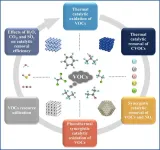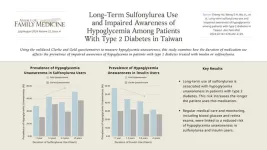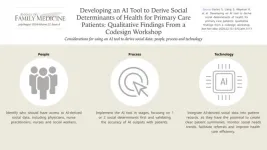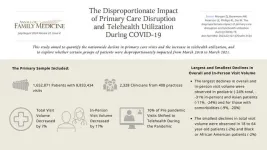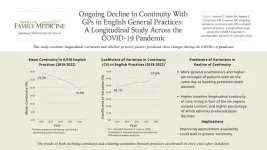(Press-News.org)
Volatile organic compounds (VOCs), with toxicity and irritability, could cause atmospheric environmental problems such as haze and photochemical smog, seriously threatening the ecological environment and human health. The primary source of VOCs is human production, such as the petrochemical industry, pharmaceutical industry, footwear industry, electronic manufacturing, and cooking fumes. Catalytic oxidation technology can highly effectively remove organic pollutants without secondary pollution, and it is receiving increasing attention in VOC pollution control. In real-world operating conditions, the coexistence of VOCs (alkanes, aromatic hydrocarbons, halogenated hydrocarbons, aldehydes, ketones, alcohol esters) and impurity gas molecules (H2O, CO2, and SO2) makes it difficult for the catalyst to remove multi-component pollutants effectively and prevent poisoning.
Recently, a research team led by Prof. Hongxing Dai and Prof. Jiguang Deng from Beijing University of Technology, China, reported the research progress of VOC elimination via thermal catalysis or photothermal catalysis over the past ten years, including eliminating single-component VOC or multi-component VOCs, synergetically purifying VOCs and NOx, and realizing VOC resource utilization. The catalytic degradation of VOCs is achieved by adopting single or composite metal oxide catalysts, porous metal oxide catalysts, supported noble metal nanocatalysts, and single-atom catalysts. A detailed summary of the pathways and mechanisms of VOC catalytic conversion has also been provided. The catalytic activity and stability of catalysts affect their lifespan and cost of use. Especially for supported noble metal catalysts, which usually have poor stability, some unique design strategies have been outlined, such as alloying strategy, reducing atmosphere treatment, or embedding noble metals into the support. The effect mechanisms of H2O, CO2, and SO2 on the catalysts in the specific VOC reaction process are sketched and assist in designing anti-poisoning catalysts. Finally, future research directions are prospected. For example, catalytic conversion of VOCs and CO2, as well as catalytic purification of VOCs and NOx, aid in the reduction of pollution and carbon emissions; thorough investigation into the mechanism of coupling external fields (light, electrical, or magnetic energy) for the thermal catalytic destruction of VOCs; developing and synthesizing innovative catalysts to accomplish broad-spectrum control of VOC pollution, as well as a deeper knowledge of the catalytic VOCs oxidation process through the combination of theoretical calculations and in situ characterization approaches.
This review may help relevant researchers in deep exchange and collision, as well as further understand or solve known and unknown problems in the catalytic oxidation of VOCs. It also might promote the progress and development of fundamental research for industrial applications. The results were published in Chinese Journal of Catalysis (https://doi.org/10.1016/S1872-2067(24)60043-4).
###
About the Journal
Chinese Journal of Catalysis is co-sponsored by Dalian Institute of Chemical Physics, Chinese Academy of Sciences and Chinese Chemical Society, and it is currently published by Elsevier group. This monthly journal publishes in English timely contributions of original and rigorously reviewed manuscripts covering all areas of catalysis. The journal publishes Reviews, Accounts, Communications, Articles, Highlights, Perspectives, and Viewpoints of highly scientific values that help understanding and defining of new concepts in both fundamental issues and practical applications of catalysis. Chinese Journal of Catalysis ranks among the top one journals in Applied Chemistry with a current SCI impact factor of 15.7. The Editors-in-Chief are Profs. Can Li and Tao Zhang.
At Elsevier http://www.journals.elsevier.com/chinese-journal-of-catalysis
Manuscript submission https://mc03.manuscriptcentral.com/cjcatal
END
HONG KONG (21 July 2024) --- The progress of solar energy technology took a step forward recently with the development of a groundbreaking living passivator at City University of Hong Kong (CityUHK) that can substantially enhance the stability and efficiency of perovskite solar cells.
This newly developed passivator is a type of corrosion inhibitor that appreciably changes the potential of a metal. The CityUHK technology leverages dynamic covalent bonds that activate on exposure to moisture and heat, enabling it to evolve new passivators in response to environmental factors.
This innovative approach allows for real-time repair and maintenance of perovskite solar cells. ...
New research presented at this year’s Annual Meeting of the European Association for Study of Diabetes (Madrid, Spain, 9-13 September) shows that the risk of developing type 1 diabetes (T1D) decreases markedly in girls after age 10 years, while the risk in boys stays the same.
Furthermore, risk of T1D is significantly higher boys with a single autoantibody than their female counterparts, suggesting the sex could be linked with autoantibody development, indicating the importance of incorporating sex in the assessment ...
Background and Goal: Sulfonylureas are a class of oral medications used to manage blood glucose levels in patients with type 2 diabetes. These drugs increase insulin production regardless of blood sugar levels. For this reason, the drugs can cause blood sugar to drop too low, leading to hypoglycemia. The goal of this study was to compare how prevalent impaired awareness of hypoglycemia was when patients with type 2 diabetes were treated with either insulin or sulfonylureas for both long and short-term periods.
Study Approach: Researchers collected data from a group of 898 participants with type 2 diabetes enrolled in pharmacies, clinics, ...
Background and Goal: Social determinants of health are the conditions in which people are born, grow, live, work, and age. These conditions include income, education, and access to health care. Knowledge of these factors is essential for primary care clinicians to deliver fair and complete care, plan programs and distribute resources effectively. However, this information is rarely captured consistently in clinical settings. This study identified how an Artificial Intelligence (AI) social determinants of health tool can be designed using a collaborative design strategy with input from primary care team members.
Study Approach: ...
Background and Goal: The COVID-19 pandemic likely worsened disparities in access to primary care. The goal of this study was to quantify the nationwide decline in primary care visits and the increase in telehealth utilization and explore whether certain groups of patients were disproportionately impacted.
Study Approach: Researchers used primary care electronic health record data from the American Family Cohort— to examine the percentage change in total visit volume, change in in-person visit volume, and telehealth ...
Background and Goal: The Transforming Clinical Practice Initiative was a four-year nationwide program aimed at improving outpatient health care quality. The initiative, funded by the Centers for Medicare & Medicaid Services, also prepared practices for payment systems based on care quality rather than service quantity and included a Change Package to guide practice transformations. This research brief examines whether these transformations were associated with reductions in emergency department visits among both primary and specialty care practices.
Study Approach: Researchers analyzed data from 3,773 practices in the Transforming Clinical Practice ...
Person-centered care focuses on treating patients as individuals with unique needs and involving them actively in their care decisions. The Person-Centered Primary Care Measure (PCPCM) is a recently developed, patient-reported survey able to assess person-centeredness. The PCPCM has demonstrated strong validity and reliability. The goal of this study was to translate the original PCPCM survey into Dutch, adapt the survey for people with low literacy, and evaluate its structure, consistency, and accuracy.
Study Approach: The survey was translated into Dutch and then back to English to ensure accuracy. The Dutch version was then tested to make sure it worked well for Dutch-speaking ...
Background and Goal: Identity discordance between patients and clinicians is associated with worse self-rated patient experience and less receipt of necessary care. Most prior studies have focused on racial discordance. However, whether these phenomena also apply to sexual and gender minority adults is currently unknown. This study evaluated how prevalent avoidance due to patient-clinician identity discordance is and its potential association with health care discrimination among sexual and gender minority ...
Background and Goal: Longitudinal continuity of care is the repeated contact between an individual and the same general practitioner (GP). This type of continuity of care is widely regarded as a cornerstone of primary care. Higher levels of longitudinal continuity of care are associated with better health outcomes, greater patient satisfaction, and more cost-effective use of health care resources. This study aimed to describe more recent variations between practices in the slopes of longitudinal continuity of care levels across the COVID-19 pandemic. The study also set out to determine if practice-related ...
Original Research
Structural Racism and Inconsistent Hospital Policies Result in Health Care Professionals Disproportionately Testing Black Newborns for Prenatal Drug Exposure
Background and Goal: Black birthing parents and their newborns disproportionately experience newborn drug testing for prenatal substance exposure by health care professionals. This practice contributes to Child Protective Services reporting, family separation, and termination of parental rights. This qualitative study, conducted at the University of Michigan in Ann Arbor, MI, explored knowledge, attitudes, and experiences ...
